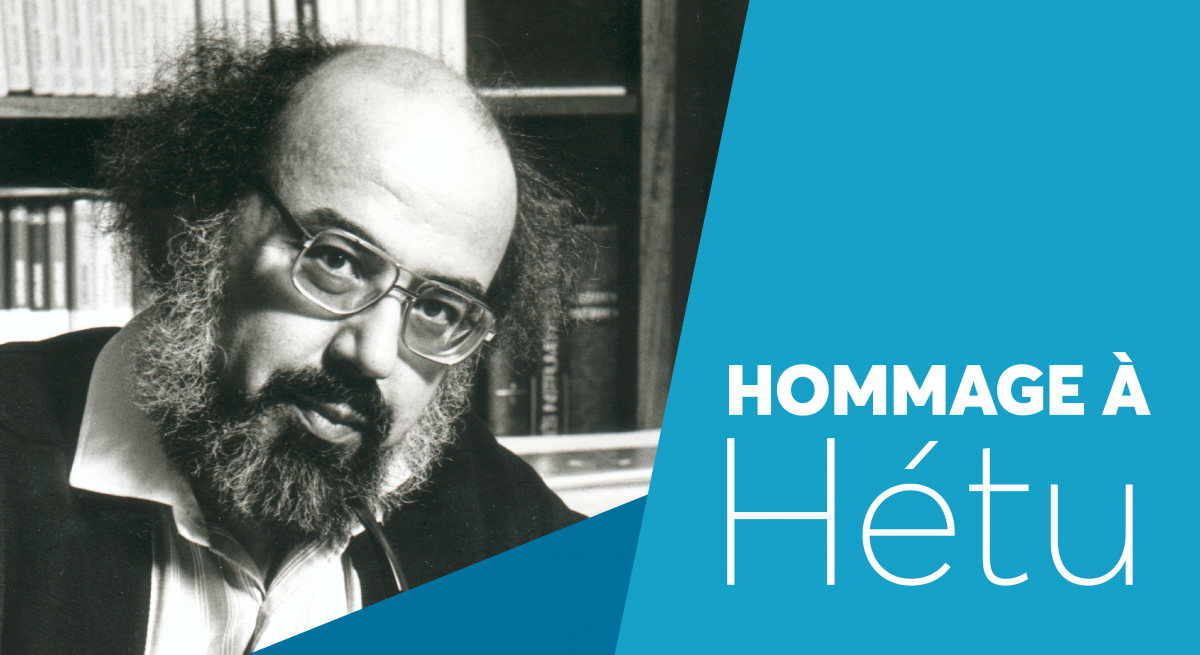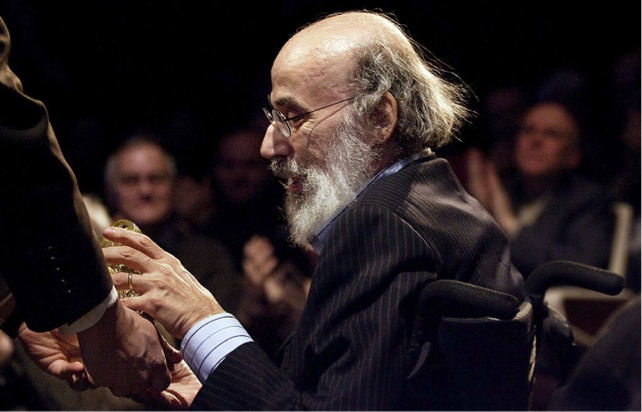By Robin Elliott, Jean A. Chalmers Chair in Canadian Music
Faculty of Music, University of Toronto
These remarks were given before a recital of music by Jacques Hétu at the Canadian Music Centre in Toronto to commemorate the tenth anniversary of Hétu’s death. My thanks to David Potvin, the organizer of this concert, for inviting me to say a few words about Hétu on that occasion, and to Matthew Fava for hosting the recital at the Canadian Music Centre, looking after the logistical and technological requirements to make it happen, and inviting me to share the talk in this written format.
Jacques Hétu enjoyed a prolific career as a composer for 50 years and as a university professor for almost 40 years. Although best known for his well crafted and beautifully orchestrated works for large performing ensembles, including five symphonies and some 20 concertos, Hétu also wrote many fine works for piano, voice, and chamber ensemble, and it is the more intimate side of his work as a composer that we will be exploring in this recital. We will hear four works for solo piano, written between 1964 and 1996, as well as the song cycle Les clartés de la nuit from 1972 to words by Hétu’s beloved poet Émile Nelligan; we end with the Cello Sonata from 1998:
Variations op. 8 for solo piano (Bryn Blackwood)
Les clartés de la nuit op. 20 for soprano and piano (Bryn Blackwood and Maeve Palmer)
Prelude et danse, op. 24 for solo piano (Jean-Luc Therrien)
Ballade op. 30 for solo piano (David Potvin)
Fantaisie op. 59 for solo piano (David Potvin)
Sonata for cello and piano, op. 63 (Younggun Kim, piano and Jun Kyu Park, cello)
Hétu’s works are available in beautifully engraved editions from the publisher Doberman-Yppan, and most of them can be heard on excellent professional recordings. Hétu is equally popular with performers and audiences; his music can be appreciated and enjoyed at first hearing, but also reveals new depths with repeated listenings. As the critic Arthur Kaptainis noted, a premiere of a work by Jacques Hétu was inevitably greeted by warm applause and curtain calls.1 Although his music is often labelled as conservative, it is imaginative, original, richly detailed, and has an unmistakable personal imprint. Unusually for a composer in the late 20th century, he gave his works opus numbers; these range from Opus 1, a Toccata for piano dating from 1959, to Opus 82, a Trio for oboe, violin and piano that was completed in 2009, shortly before his death at the age of 71. One of his grandest works, his Fifth Symphony in four movements with a choral finale (like Beethoven’s Ninth), was commissioned by the Toronto Symphony, which gave the first performance under Peter Oundjian in March 2010, less than a month after the composer’s death.
In thinking about how to honour Hétu in this short video introduction and tribute, I decided to tell the story of Hétu’s life in chronological order, by showing and commenting on a series of photos. I call my talk “Jacques Hétu: A Life in Six Pictures”.
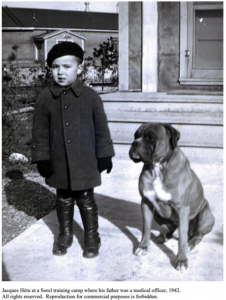
Jacques Hétu at a Sorel training camp where his father was a medical office, 1942. All rights reserved. Reproduction for commercial purposes is forbidden.
This first photo dates from 1942.2 Hétu was born in Trois-Rivières, Quebec on August 8th, 1938, just over a year before the start of World War Two. Trois-Rivières is located half-way between Quebec City and Montreal, and eventually Hétu would gravitate to both of those major centres, spending the first part of his career in Quebec City and the last part of it in Montreal. In this photo, the four-year-old Hétu looks at the camera somewhat apprehensively, with the family bulldog by his side. The photo was taken not in Trois-Rivières, but rather in a military training camp in Sorel, where his father, a doctor, had been relocated during the war. A year after this photo was taken, Hétu was sent to boarding school in Montreal, where he would spend ten not particularly happy years. In 1946, four years after this photo was taken, an event took place which would change his life forever; he bought a recording of Schubert’s Unfinished Symphony and fell deeply and permanently in love with music.3 It would take another seven years before he acted decisively upon that love, dropping out of Brébeuf College in Montreal at the age of 15 to devote himself to music studies. Although he had left Trois-Rivières behind by then, he did not forget the city of his birth, nor did it forget him. A music school in Trois-Rivières was named École de musique Jacques-Hétu in his honour 25 years ago, and late in his career, Hétu wrote a series of major works for the Trois-Rivières Symphony Orchestra: Variations concertantes, Opus 74 in 2005, a Viola Concerto in 2006, and Sur les rives du Saint-Maurice in 2008.
Beginning serious music studies only at the age of 15, Hétu was a late starter but a quick learner. Within six months he was already writing music prolifically. One night while he was listening to the radio, he had another transformative experience. He was spellbound by a performance of a piece of modern music and decided immediately to seek out the composer of that work, who was Clermont Pépin.4 And so, at the age of 18, he began his studies with Pépin at the Conservatoire de musique du Québec à Montréal. Five years later, upon graduating, he won the conservatory’s premier prix in composition.
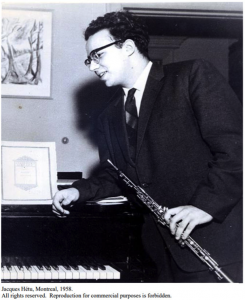
Jacques Hétu, Montreal, 1958. All rights reserved. Reproduction for commercial purposes is forbidden.
This second photo dates from 1958, when Hétu was in the midst of his studies at the Montreal Conservatory.5 It pictures him with the two instruments on which he was having lessons at the time: piano and oboe (in addition to his composition studies with Pépin). One could hazard a guess that it was his oboe studies with Melvin Berman, the principal oboist of the Montreal Symphony at the time, that led Hétu deeply into the world of orchestral music. The orchestral sound world would become Hétu’s natural medium, the one in which he made arguably his most sustained and most important contributions. But he would also write many important works for solo piano, informed by his studies with the versatile pianist and composer Georges Savaria at the Montreal Conservatory.
The composition prize from the Montreal Conservatory, along with the prestigious Prix d’Europe and a grant from the Canada Council, allowed Hétu to spend two years studying music in Paris, from 1961 to 1963. He absorbed the exciting musical atmosphere of the French capital, attending concerts by Pierre Boulez among others, and studying analysis with Olivier Messiaen. After briefly exploring an avant-garde compositional idiom à la Boulez during his studies in France, Hétu decided that his heart was not in the more experimental trends of music in the 1960s. He found an ideal composition teacher in Henri Dutilleux, recently appointed to teach composition at the École normale in Paris. Dutilleux encouraged Hétu to remain true to his convictions about his musical idiom, which Hétu pithily described as “neo-classical forms and neo-romantic effects in a musical language using 20th-century techniques.”6 Upon returning to Canada in 1963, Hétu took up a position at Laval University in Quebec City, which would be his home for the next 14 years. The first composition Hétu wrote after returning to Canada is the opening work on this recital and is the work that made Hétu’s reputation as a composer: his Variations for piano, Opus 8, of 1964.
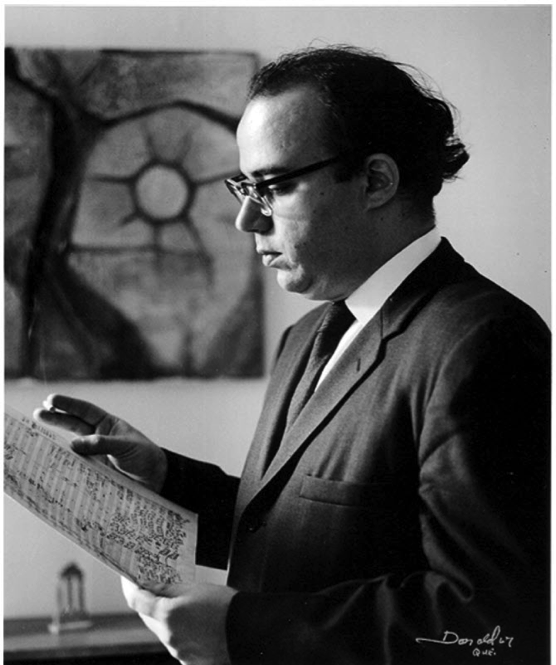
Jacques Hétu, 1967. Photograph: Studio Donald. All Rights Reserved. Reproduction for commercial purposes is forbidden.
In this third photo, dating from 1967,7 Hétu studies a page of his orchestral music while casually smoking a cigarette; he has not yet taken up the pipe that would become his constant companion in later years. It was in this year, 1967, that Glenn Gould recorded Hétu’s Variations. In 1992 Hétu told me jokingly that he was sick for three days when he first heard Gould’s recording of the Variations, as it was so at odds with Hétu’s own vision of the work. “But,” he added, “I also realized that how Gould played the work was less important than the fact that he had recorded it.” Indeed, the Gould recording instantly lifted Hétu’s career to a new level; he quickly received four new commissions on the strength of Gould’s advocacy of his music, and from that point onwards the commissions and performances continued without letting up to the end of his life.

Jacques Hétu while teaching at the University of Quebec in Montreal, 1980. All rights reserved. Reproduction for commercial purposes is forbidden.
In this fourth photo, we skip ahead to 1980.8 Hétu moved from Quebec City to Montreal in 1978, and after teaching at l’Université de Montréal for a year, he took up a position at l’Université du Québec à Montréal in 1979. He would remain there for 21 years, until his retirement from academic life in 2000. UQÀM had only been founded ten years before Hétu arrived there; he was instrumental in growing the music offerings and served two terms as the Director of the Department of Music in the 1980s. Teaching music analysis was Hétu’s day job; files preserved among the Hétu papers at Library and Archives Canada attest to the seriousness with which he approached his activities as a teacher of music students, as well as students from other disciplines and community members, during his time at UQÀM. Note that Hétu has by now grown the beard that was to define his appearance for the rest of his life. Here it is still professorial in nature, but eventually it turned white and grew to positively Biblical proportions. Incidentally earlier this year, the Department of Music at UQÀM honoured Hétu’s memory by giving a commemorative recital of his music, concentrating, like this one, on his solo and chamber works.
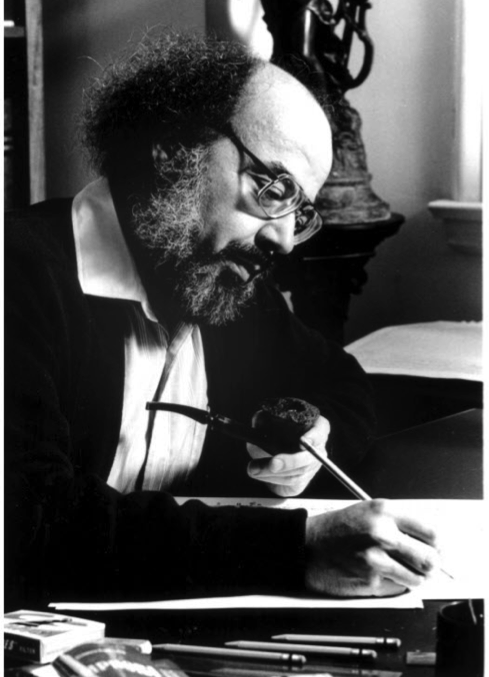
Jacques Hétu, 1984. Photograph: Takashi Seida. All rights reserved. Reproduction for commercial purposes is forbidden.
This fifth photo was taken by Takashi Seida in 1984 and is one of the most widely reproduced images of the composer.9 With pipe in hand, he commits notes to paper with a look of calm resolve. “I am so happy when I compose,” Hétu told Eitan Cornfield in 2002. “It’s a way of life; I call it work … it’s work, yes, very hard work, but so extraordinary to put these sounds together.”10 Hétu would spend up to 14 hours a day composing in the studio in his house near Saint Hippolyte in the Laurentians, an hour’s drive north of Montreal. Surrounded by forest, lakes, and the sounds of nature, Hétu turned out a steady stream of works on commission and became even more productive after his retirement from university teaching in 2000.11
Our sixth and final image of Hétu (see next page) dates from 2010, just ten days before his death on February 9th of that year.12 In this photo by François Pesant for Le Devoir, Hétu accepts an Opus Award for lifetime achieve-ment from the Quebec Music Council. This was the last in a long list of honours that he received, including being elected a member of the Royal Society of Canada in 1989, and being named an Officer of the Order of Canada in 2001 and of the Order of Québec in 2007. But perhaps the most significant recognition he received came from the performances of his music by leading musicians across Canada, and also abroad by groups such as the New York Philharmonic and l’Orchestra national de France, among many others.
The interest in Hétu’s music remains high, as recent recordings of his orchestral music by the Laval Symphony under Alain Trudel and of his complete chamber music for strings by the New Orford String Quartet reveal. I hope that you will enjoy this recital of music from across various stages of Hétu’s career, and that it will encourage you to learn more about this remarkable and hugely talented composer.
[article completed on 24 September 2020]
NOTES
1 Arthur Kaptainis, spoken remarks included in the Hétu documentary produced and presented by Eitan Cornfield and released on the CD Canadian Composers Portraits: Jacques Hétu, Centrediscs CD-CMCCD 8302 (2002).
2 The photo is from Stéphane Jean, The Jacques Hétu Fonds: Numerical List / Le fonds Jaques Hétu, repertoire numérique (Ottawa: Music Division, National Library of Canada, 1999): 10 (this source is available online at https://www.collectionscanada.gc.ca/obj/028021/f2/04-e.pdf).
3 See Thérèse Boutin, “Type symphonie ou type concerto?” Prélude: Le magazine électronique de l’Orchestre symphonique de Trois-Rivières, vol. 1, no. 1 (Sept. 2007): 4. “Encore aujourd’hui, l’œuvre qui guide Jacques Hétu est la 8e symphonie de Schubert, l’inachevée. En 1946, à l’âge de 8 ans, il achète son premier disque de cette œuvre qu’il n’a de cesse d’écouter.” The article is online here: http://collections.banq.qc.ca/ark:/52327/bs1948607.
4 The story of hearing a work by Pépin on the radio and deciding to study with him is related in the Jacques Hétu audio documentary produced and presented by Eitan Cornfield (see n. 1).
5 This photo is taken from Stéphane Jean, The Jacques Hétu Fonds: Numerical List, p. 19.
6 Jacques Hétu, as quoted in Claire Versailles and Rachelle Taylor, “Jacques Hétu,” The Canadian Encyclopedia (online), https://www.thecanadianencyclopedia.ca/en/article/jacques-hetu (accessed 24 Sept. 2020).
7 This photo is taken from Stéphane Jean, The Jacques Hétu Fonds: Numerical List, p. 34.
8 This photo is taken from Stéphane Jean, The Jacques Hétu Fonds: Numerical List, p. 17.
9 This photo is taken from Stéphane Jean, The Jacques Hétu Fonds: Numerical List, p. 3.
10 Jacques Hétu, as told to Eitan Cornfield (see n. 1)
11 For a description of Hétu’s compositional habits, see René Champigny, “Jacques Hétu: The Joy of Composing,” La scena musicale (1 July 2008): available online in both English and French at http://www.scena.org/lsm/sm13-10/sm13-X_hetu_en.html (accessed 24 Sept. 2020).
12 This photo accompanies the anonymous obituary of Jacques Hétu that was published in Le Devoir on 10 Feb. 2020; it is online at https://www.ledevoir.com/culture/musique/282803/le-compositeur-jacques-hetu-n-est-plus.
SOURCES
Anonymous, “Le compositeur Jacques Hétu n’est plus [obituary].” Le Devoir [Montreal], 10 Feb. 2020; online at https://www.ledevoir.com/culture/musique/282803/le-compositeur-jacques-hetu-n-est-plus
Boutin, Thérèse. “Type symphonie ou type concerto? [interview with Jacques Hétu].” Prélude: Le magazine électronique de l’Orchestre symphonique de Trois-Rivières, vol. 1, no. 1, Sept. 2007; available online at http://collections.banq.qc.ca/ark:/52327/bs1948607
Champigny, René. “Jacques Hétu: The Joy of Composing / Jacques Hétu : Le bonheur de composer.” La scena musicale, 1 July 2008; online at http://www.scena.org/lsm/sm13-10/sm13-X_hetu_fr.html
Cornfield, Eitan, producer and presenter. “Jacques Hétu Audio Documentary.” Available on the CD Canadian Composers Portraits: Jacques Hétu, Centrediscs CMCCD 8302. 2002.
Hryciw, Theresa Mary Elizabeth. “A Study of the Variations pour piano by Jacques Hétu.” MMus thesis, University of Alberta. 1978; available online at https://archive.org/details/hryciw1978/page/n5/mode/2up
Jean, Stéphane. The Jacques Hétu Fonds: Numerical List / Le fonds Jaques Hétu, repertoire numérique. Ottawa: Music Division, National Library of Canada, 1999; available online at https://www.collectionscanada.gc.ca/obj/028021/f2/04-e.pdf
Kaptainis, Arthur. “Composer Jacques Hétu has Died, Age 71,” Montreal Gazette, 10 Feb. 2010; a version is online at http://www.classicalmusicguide.com/viewtopic.php?t=33845
Versailles, Claire and Rachelle Taylor. “Jacques Hétu.” The Canadian Encyclopedia (online), https://www.thecanadianencyclopedia.ca/en/article/jacques-hetu
Note: A complete list of works by Hétu is available in the French-language Wikipedia article about him, available online at https://fr.wikipedia.org/wiki/Jacques_H%C3%A9tu.

